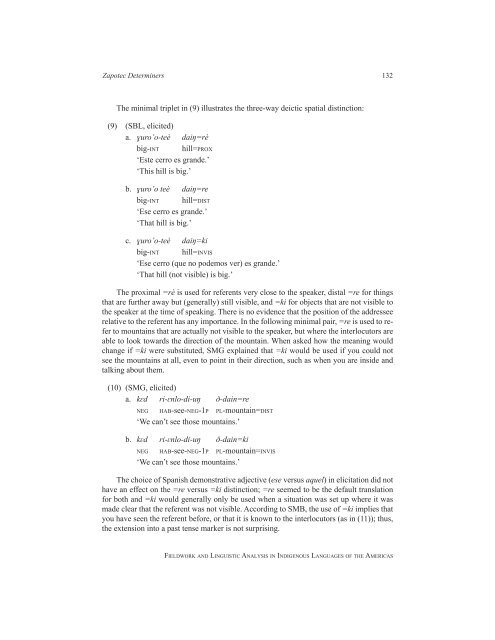Fieldwork and Linguistic Analysis in Indigenous ... - ScholarSpace
Fieldwork and Linguistic Analysis in Indigenous ... - ScholarSpace
Fieldwork and Linguistic Analysis in Indigenous ... - ScholarSpace
Create successful ePaper yourself
Turn your PDF publications into a flip-book with our unique Google optimized e-Paper software.
Zapotec Determ<strong>in</strong>ers 132<br />
The m<strong>in</strong>imal triplet <strong>in</strong> (9) illustrates the three-way deictic spatial dist<strong>in</strong>ction:<br />
(9) (SBL, elicited)<br />
a. ɣuro’o-teè daiŋ=rè<br />
big-<strong>in</strong>t hill=Prox<br />
‘Este cerro es gr<strong>and</strong>e.’<br />
‘This hill is big.’<br />
b. ɣuro’o teè daiŋ=re<br />
big-<strong>in</strong>t hill=dist<br />
‘Ese cerro es gr<strong>and</strong>e.’<br />
‘That hill is big.’<br />
c. ɣuro’o-teè daiŋ=ki<br />
big-<strong>in</strong>t hill=<strong>in</strong>vis<br />
‘Ese cerro (que no podemos ver) es gr<strong>and</strong>e.’<br />
‘That hill (not visible) is big.’<br />
The proximal =rè is used for referents very close to the speaker, distal =re for th<strong>in</strong>gs<br />
that are further away but (generally) still visible, <strong>and</strong> =ki for objects that are not visible to<br />
the speaker at the time of speak<strong>in</strong>g. There is no evidence that the position of the addressee<br />
relative to the referent has any importance. In the follow<strong>in</strong>g m<strong>in</strong>imal pair, =re is used to refer<br />
to mounta<strong>in</strong>s that are actually not visible to the speaker, but where the <strong>in</strong>terlocutors are<br />
able to look towards the direction of the mounta<strong>in</strong>. When asked how the mean<strong>in</strong>g would<br />
change if =ki were substituted, SMG expla<strong>in</strong>ed that =ki would be used if you could not<br />
see the mounta<strong>in</strong>s at all, even to po<strong>in</strong>t <strong>in</strong> their direction, such as when you are <strong>in</strong>side <strong>and</strong><br />
talk<strong>in</strong>g about them.<br />
(10) (SMG, elicited)<br />
a. kɛd ri-ɛnlo-di-uŋ ð-da<strong>in</strong>=re<br />
neg hab-see-neg-1P Pl-mounta<strong>in</strong>=dist<br />
‘We can’t see those mounta<strong>in</strong>s.’<br />
b. kɛd ri-ɛnlo-di-uŋ ð-da<strong>in</strong>=ki<br />
neg hab-see-neg-1P Pl-mounta<strong>in</strong>=<strong>in</strong>vis<br />
‘We can’t see those mounta<strong>in</strong>s.’<br />
The choice of Spanish demonstrative adjective (ese versus aquel) <strong>in</strong> elicitation did not<br />
have an effect on the =re versus =ki dist<strong>in</strong>ction; =re seemed to be the default translation<br />
for both <strong>and</strong> =ki would generally only be used when a situation was set up where it was<br />
made clear that the referent was not visible. Accord<strong>in</strong>g to SMB, the use of =ki implies that<br />
you have seen the referent before, or that it is known to the <strong>in</strong>terlocutors (as <strong>in</strong> (11)); thus,<br />
the extension <strong>in</strong>to a past tense marker is not surpris<strong>in</strong>g.<br />
fieldwork <strong>and</strong> l<strong>in</strong>guistic analysis <strong>in</strong> <strong>in</strong>digenous languages of the americas

















